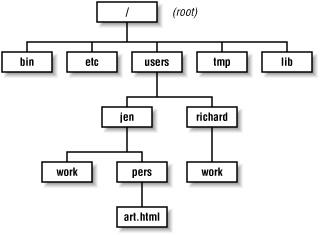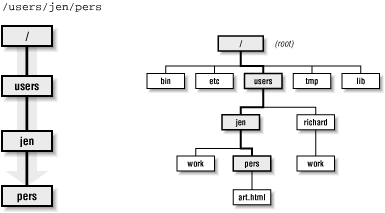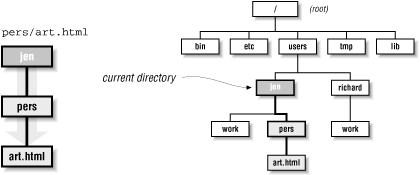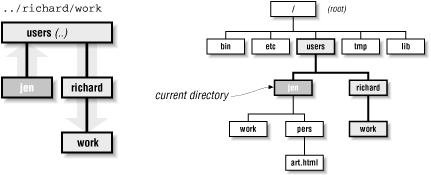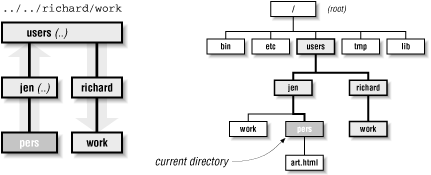Because the Web was spawned from the Unix environment, it follows many of the same conventions. Directory structure and pathname syntax are prime examples. It is important for all web designers to have an understanding of how directory structures are indicated on the Unix platform since pathnames are used in hyperlinks and pointers to images and other resources.
Directories (“places” to store files) are organized into
a hierarchical structure that fans out like an upside-down tree. The
topmost directory
is
known as the root and is written as a forward
slash ( / ).
The root can contain several directories,
each of which can contain subdirectories; each of these can contain
more subdirectories, and so on. A subdirectory is said to be the
“child” of the directory that holds it (its
“parent”). Figure 4-1 shows a system
with five directories under the root. The directory
users has two subdirectories, jen
and richard. Within jen
are two more subdirectories, work and
pers, and within pers is
the file art.html.
A pathname is the notation used to point to a particular file or directory; it tells you the path of directories you must travel to get to where you want to go. There are two types of pathnames: absolute and relative.
An absolute pathname
always starts from the root
directory, which is indicated by a slash ( / ). So, for example, the
pathname for the pers directory is
/users/jen/pers, as shown in Figure 4-2
.The
first slash indicates that we are starting at the root and is
necessary for indicating that a pathname is absolute.
A relative pathname points to a file or directory relative to your current working directory. When building a web site on a single server, relative pathnames are commonly used within URLs to refer to files in other directories on the server.
Unless you specify an absolute name (starting with a slash), the server assumes you are using a relative pathname. Starting in your current location (your working directory), you can trace your way up and down the directory hierarchy. This is best explained with an example.
If I am currently working in the directory jen
and I want to refer to the file art.html, the
relative pathname is pers/art.html, because the
file art.html is in the directory
pers, which is in the current directory,
jen. This is illustrated in Figure 4-3.
Going back up the hierarchy is a bit trickier. You go up a level by using the shorthand .. for the parent directory. Again, let’s use an example based on Figure 4-1.
If I am currently in the jen directory, and I
want to refer to the directory richard /work,
the pathname is .. /richard /work. The two dots
at the beginning of the path take us back up one level to the to the
users directory, and from there we find the
directory called richard and the subdirectory
called work, as shown in Figure 4-4.
If I am currently in my pers directory and I
want to refer to Richard’s work directory,
I need to go up two levels, so the pathname would be .. /..
/richard /work, as shown in Figure 4-5.
Note that the absolute path /users/richard /work
accomplishes the same thing. The decision whether to use an absolute
versus a relative pathname generally comes down to which is easiest
from where you
are.
When pointing to another web page or resource (like an image) on your
own server, it is common to use a relative URL, one that points to
the new resource relative to the current document. Relative URLs
follow the syntax for pathnames described above. For example, a
hypertext link to art.html from another document
in the pers directory would look like this:
<A HREF="art.html">
The URL for the link could also be written starting from the root directory:
<A HREF="/users/jen/pers/art.html">
Image tags also use pathnames to point to the graphic file to be
displayed. For instance, this image tag in the art.html
document:
<IMG SRC="../../daisy.gif">
points to a graphic named daisy.gif located in
the jen directory
. Two
"../“s indicate that the graphic file
resides in a directory two levels higher than the current document
(art.html).
If you plan on doing your HTML coding by hand, pathname syntax will come naturally after a little practice. If you are using a WYSIWYG authoring tool (such as Macromedia Dreamweaver, Adobe GoLive, or Microsoft FrontPage), you have the luxury of letting the tool construct the relative URL pathnames for you. Some even have site management tools that automatically adjust the pathnames if documents get moved.
Get Web Design in a Nutshell, 2nd Edition now with the O’Reilly learning platform.
O’Reilly members experience books, live events, courses curated by job role, and more from O’Reilly and nearly 200 top publishers.
